The Audi A4 is a compact executive car produced by the German automaker Audi since 1994. The first generation A4 succeeded the Audi 80.
It is available as a saloon/sedan or a estate/wagon (Audi calls it the "Avant"). The 2nd (B6) and 3rd generations (B7) of the A4 also had a Cabriolet version, which was not retained for the 4th generation (B8), due to the introduction of the related A5 coupé/cabriolet.
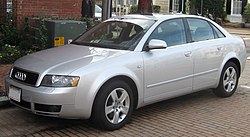 | |
| Manufacturer | Audi AG |
|---|---|
| Parent company | Volkswagen Group |
| Production | 1994 – present |
| Assembly | Ingolstadt, Germany |
| Predecessor | Audi 80 |
| Class | Compact executive car |
| Layout | Front engine, front wheel drive, quattro permanent four-wheel drive |
| Platform | Volkswagen B platform |
| Related | Audi S4 Audi RS4 |
B5 (Typ 8D, 1994–2001)
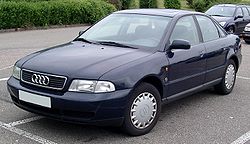 | |
| Production | 1994–2001 |
|---|---|
| Predecessor | Audi 80 (B4) |
| Successor | Audi A4 (B6) |
| Body style(s) | 4-door saloon/sedan, 5-door Avant (estate/wagon) |
| Platform | Volkswagen B5 platform |
| Engine(s) | 1.6L I4 1.8L I4 20V 1.8L I4 20V Turbo 2.4L V6 30V 2.6L V6 2.8L V6 2.8L V6 30V 2.7L V6 30V Turbo; 1.9L I4 TDI 2.5L V6 24V TDI |
| Transmission(s) | 5-speed manual; 4 speed automatic; 5-speed ZF 5HP19 automatic |
| Wheelbase | 2615 mm (103 in) |
| Length | 4520 mm (178 in); Avant: 4488 mm (176.7 in) |
| Width | 1730 mm (68.1 in) |
| Height | 1415 mm (55.7 in); Avant: 1440 mm (56.7 in) |
| Fuel capacity | 62 litres (16.4 US gal; 13.6 imp gal) |
| Related | Audi S4 (B5), Audi RS4 (B5) Škoda Superb Volkswagen Passat (B5) |
The first-generation Audi A4 (known internally as the Typ 8D) was debuted by Audi in 1994 on the Volkswagen B5 platform, which it shared with the fourth generation Volkswagen Passat. It had a longitudinal engine and standard front-wheel drive, although many of the A4 owners selected the optional quattro four-wheel drive system. The A4 was initially introduced as a four-door saloon/sedan; the Avant (estate/wagon) arrived a year later.
A wide range of engines were available to European customers, between 1.6 and 2.8 litres, and a 1.9 L Diesel available with VW's new "Pumpe Düse" (PD, or unit injector) technology, capable of achieving a then high power value of 110 PS (81 kW), although Audi's 2.8 L V6, carried over from the old 80/90 was the only engine option in North America until 1997.
The Audi A4 was the first model in the Volkswagen Group to feature the new 1.8 L 20V motor with five valves per cylinder, based on the unit Audi Sport had developed for their Supertouring race car. A turbocharged version produced 150 PS (110 kW) and 210 Nm (155 ft·lbf.) of torque. This technology was added to the V6 family in 1996, starting with the 2.8 L V6 30V, which now produced 193 PS (142 kW).
Audi also debuted their new Tiptronic transmission on the B5 platform, based on the unit Porsche developed for their 964-generation 911. The transmission is a conventional automatic gearbox with a torque converter, but it offers the driver a choice of driving the car as either a fully automatic operation or with a manual override of the gear ratios.
B5 facelift (1998–2001)
A refreshed B5 A4 range appeared at the 1997 Frankfurt Motor Show, with sales beginning in Europe in early 1998. Besides the introduction of a 2.8 L 30-valve V6 (replacing the 2.8 L 12-valve), the most important additions to the range were the 2.5 L V6 TDI diesel engine with 150 PS (110 kW) and standard quattro, and a six-speed gearbox, as well the new high-performance S4, now part of the A4 lineup (the previous S4 had been an Audi 100). New taillights, headlights, door handles, and other minor exterior/interior changes rounded out the cosmetic updates.
In mid 1998, the 1.8T engine available outside Europe had its power output raised to 170 PS (125 kW). This was accomplished by upgrading the previous KKK KO3 turbocharger with a KO3s(sport) unit. The 12-valve V6 was replaced by the 30-valve unit that had been available in Europe for two years. In 1999, Audi debuted an even higher performance RennSport model, the RS4 Avant, like its predecessor RS2 available only in the Avant bodystyle.
Safety
The Audi A4 (B5) received 3 stars for front- and side-impact protection, but the last star is flagged to indicate that the driver may be subjected to a high risk of chest injury in the side impact.
B6 (Typ 8E/8H, 2001–2005)
 | |
| Production | 2001–2005 |
|---|---|
| Predecessor | Audi A4 (B5) |
| Successor | Audi A4 (B7) |
| Body style(s) | 4-door saloon/sedan 5-door Avant (estate/wagon) 2-door cabriolet |
| Platform | Volkswagen B6 (PL46) platform |
| Engine(s) | 1.6 L I4, 2.0 L I4 20V, 2.0L I4 FSI 16V; 1.8 L I4 20V Turbo; 2.4 L V6 30V, 3.0 L V6 30V, 1.9 L I4 TDI, 2.5 L V6 TDI, 3.0 L V6 TDI |
| Transmission(s) | 5 and 6-speed manual; 4, 5 and 6-speed automatic, front wheel drive or quattro permanent four-wheel drive |
| Wheelbase | 2650 mm (104.3 in), Cabriolet: 2654 mm (104.5 in) |
| Length | 4547 mm (179 in), Avant: 4544 mm (178.9 in); Cabriolet: 4573 mm (180 in) |
| Width | 1766 mm (69.5 in), Cabriolet: 1777 mm (70 in) |
| Height | 1428 mm (56.2 in), Cabriolet: 1391 mm (54.8 in) |
| Fuel capacity | 66 litres (17.4 US gal; 14.5 imp gal) |
| Related | Audi S4 (B6) |
An all-new A4, internally designated Typ 8E, debuted in late 2000, now riding on the all new Volkswagen B6 (PL46) platform. The car's new styling was inspired on the C5 (second-generation) Audi A6. The 1.6 L base model remained unchanged, but most other petrol/gasoline engines received either displacement increases, or power upgrades. The 1.8 L 20-valve Turbo was now available in two additional versions, with 150 or 180 PS (110 or 132 kW), this one with a standard six-speed gearbox, while the naturally aspirated 1.8 L straight-4 and 2.8 L V6 were replaced by 2.0 L and all-aluminium 3.0 L units, still with five valves per cylinder, the most powerful of which was capable of 220 PS (162 kW) and 300 Nm (221 ft·lbf) of torque. The 1.9 TDI engine was upgraded to 130 PS and was now available with quattro permanent four-wheel drive, while the 2.5 V6 TDI high-end model was introduced with 180 PS (132 kW) and standard quattro. The Avant arrived in mid 2001. This generation of quattro consists of default of 50:50 front to rear torque distribution, infinitely variable up to 25:75 or 75:25.
For 2002, Audi upgraded power in the 1.8 Turbo engines to 163 and 190 PS (120 and 140 kW respectively) - 190 designated by a red T, with both available with quattro, and in the 2.5 TDI intermediate version to 163 PS. A 2.0 engine with Fuel Stratified Injection was also available. A year later, Audi reintroduced the S4, now powered by a 344 PS (253 kW) 4.2 L V8 engine, as well as an A4 Cabriolet convertible variant (Typ 8H), finally replacing the 80-based Audi Cabriolet that had been discontinued in 1998. It included an electro-hydraulic operated hood, which lowered in under 30 seconds and incorporated some styling changes which eventually found their way to the saloon version (such as body-colored lower bumper and sill panels).
Audi also introduced a continuously variable transmission developed by LuK, named multitronic, which replaced the Tiptronic on front-wheel drive models. The transmission won considerable praise from the automotive press, and is generally regarded as being the best of its type in the world, due to its light weight and promptness in response, but its use was limited to models with a maximum of 310 Nm (229 ft·lbf).
Borrowing from the Audi A6, the boot was redesigned to remove the extension of the top edge with a smoother fold line, and the taillight assembly now forms part of the top line.
An "Ultra sport package" named Ultra Sport was introduced in the North American market shortly before the B6 was replaced by the B7. It included aluminium interior trim and door sills, "S line" steering wheel, front and rear spoilers, side valence and 18-inch (460 mm) RS4 wheels.
Engines
| Engine | Cyl. | Power |
|---|---|---|
| 1.6 | I4 | 102 PS (101 hp/75 kW) |
| 2.0 20V | I4 | 130 PS (128 hp/96 kW) |
| 2.0 16V FSI | I4 | 150 PS (148 hp/110 kW) |
| 1.8T 20V | I4 | 150 PS (148 hp/110 kW) / 163 PS (161 hp/120 kW) |
| 1.8T 20V S-Line | I4 | 180 PS (178 hp/132 kW) / 190 PS (187 hp/140 kW) |
| 2.4 30V | V6 | 170 PS (168 hp/125 kW) |
| 3.0 30V | V6 | 220 PS (217 hp/162 kW) |
| S4 4.2 | V8 | 344 PS (339 hp/253 kW) |
| 1.9 TDI | I4 | 100 PS (99 hp/74 kW) / 115 PS (113 hp/85 kW) / 130 PS (128 hp/96 kW) |
| 2.5 24V TDI | V6 | 155 PS (153 hp/114 kW) / 163 PS (161 hp/120 kW) / 180 PS (178 hp/132 kW) |
Safety
The Audi A4 (B6) passed the Euro NCAP crash tests, and was awarded the following car safety ratings: [4]
- Adult occupant =





- Pedestrian =



 (pre 2002 rating)
(pre 2002 rating)
B7 (Typ 8E/8H, 2005–2008)
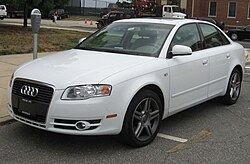 | |
| Production | 2005–2008 |
|---|---|
| Predecessor | Audi A4 (B6) |
| Successor | Audi A4 (B8) |
| Body style(s) | 4-door saloon/sedan, 5-door Avant (estate/wagon), 2-door convertible |
| Platform | Volkswagen B6 (PL46) platform |
| Engine(s) | 1.6 L I4, 2.0 L 20V I4, 1.8 L I4 20V T, 1.8 L I4 TFSI, 2.0 L I4 TSFI, 3.2 L V6 FSI, 1.9 L I4 TDI, 2.0 L I4 TDI, 2.7 L V6 TDI, 3.0 L V6 TDI |
| Transmission(s) | 5 and 6-speed manual, 6-speed automatic, CVT |
| Wheelbase | 2648 mm (104.3 in) |
| Length | 4586 mm (180.6 in), Cabriolet: 4573 mm (180 in) |
| Width | 1772 mm (69.8 in), Cabriolet: 1777 mm (70 in) |
| Height | 1427 mm (56.2 in), Cabriolet: 1518 mm (59.8 in) |
| Fuel capacity | 70 litres (18.5 US gal; 15.4 imp gal); RS4: 63 litres (16.6 US gal; 13.9 imp gal) |
| Related | Audi S4 (B7), Audi RS4 (B7) SEAT Exeo |
Audi introduced a heavily revised A4 in late 2004, with the internal designation of B7. However, this new range A4 still utilised the existing Volkswagen B6 (PL46) platform, a chassis derived from the outgoing B6, but enjoyed heavily revised steering settings, suspension geometry, new engine ranges, navigation systems and chassis electronics (a new advanced Bosch 8.0 ESP system). Audi's internal platform nomenclature uses PL46 (longitudinal passenger car platform, size 4, generation 6) for both B6 and B7 chassis. The Typ 8E and 8H internal designations are also unchanged from the B6 A4.
The engine lineup received many additions. The 2005 introduction of Fuel Stratified Injection (FSI) on the 2.0 TFSI and 3.2 V6 FSI petrol/gasoline engines, as well as other refinements, increased power output to 200 and 255 PS (147 and 188 kW), respectively. These engines both implement a four-valve per cylinder design. The prior 5-valve design was incompatible with the FSI direct injection system. The 2.0 TDI diesel engine now combines Pumpe Düse (PD) technology with 16 valves for the first time, while the larger 2.5 TDI was increased to 3.0 L, offering 204 PS (150 kW). quattro permanent four-wheel drive remained available on most A4 models. Audi retired its 5-speed manual transmissions in favour of a 6-speed. As before, multitronic transmission is available on front-wheel drive models, while a 6-speed Tiptronic transmission is available on quattro four-wheel drive models.
In addition to the higher-performance S4, which carried over the powertrain of the B6 S4, Audi has reintroduced the ultra-high performance RS4 (RS for RennSport) to the lineup, for the first time on the saloon/sedan and Cabriolet body and with a normally aspirated 4.2 V8 FSI engine. Another notable inclusion is the 3rd-generation Torsen T-3 quattro system, which uses a 'default' asymmetric 40:60 front-rear torque distribution (this new asymmetric centre differential was only available initially on the RS4, and later, on the S4. The remainder of the A4 range still utilised the 50:50 split diff). A limited edition variant first introduced in late 2005, named "DTM Edition", was reintroduced in 2006 as a regular option, the 2.0T FSI engine now engineered to 220 PS (162 kW) with standard quattro. The front grill assembly has changed to be a tall trapezoidal shape in the same manner as the C6 (third-generation) Audi A6.
The B7 Cabriolet model arrived later than the other two body variants, with sales beginning in February 2006. Brand new on the Cabriolet was an entry-level 2.0 TDI version, but to date this is not being offered with the Multitronic gearbox.
The Audi A4 offers many safety features, including side airbags, anti-lock brakes (ABS), Electronic Stabilization Programme, and its optional quattro four-wheel drive. It also received the IIHS "Top Safety Pick For 2007".
According to 2007 Swedish vehicle inspection data, the A4 Avant with diesel engine is the most reliable vehicle available on the market, with vehicle inspection rejection rate of 0.0% in 3 year old category.
The B7 series A4 was facelifted and rebadged as the SEAT Exeo in 2008, with styling changes to the front and rear, also incorporating interior trim from the A4 Cabriolet.
Engines
B8 (Typ 8K, 2008–present)
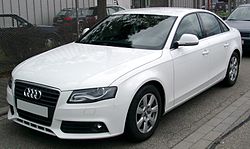 | |
| Production | 2008–present |
|---|---|
| Predecessor | Audi A4 (B7) |
| Body style(s) | 4-door saloon/sedan, 5-door Avant (estate/wagon) |
| Platform | Volkswagen B8 (MLB/MLP) platform |
| Engine(s) | 1.8L TFSI I4, 3.2L V6 FSI, 2.0L TDI I4, 2.7L V6 TDI, 3.0L V6 TDI |
| Transmission(s) | 6-speed manual, 6-speed automatic, multitronic CVT |
| Wheelbase | 2808 mm (110.6 in) |
| Length | 4703 mm (185.2 in) |
| Width | 1826 mm (71.9 in) |
| Height | 1427 mm (56.2 in); Avant: 1436 mm (56.5 in) |
| Related | Audi A5, Audi S4 (B8) |

Audi released the first official pictures of the B8 series A4 in August 2007, and unveiled the car to the public at the September 2007 Frankfurt Motor Show. Saloon/sedan and Avant (estate/wagon) models are offered. The Avant was unveiled to the public at the March 2008 Geneva Auto Show.
The B8 A4 is built on a variant of the Audi Modular Longitudinal Platform, a platform which is also used in the Audi A5 coupé. Whilst prior A4 chassis were limited in wheelbase due to the relationship between the engine, transmission and front axle, the MLP allows for a reduced front overhang, resulting in a greater wheelbase length without the same increase in overall length. This effectively redistributes the center of gravity slightly rearwards, improving handling by better balancing vehicle mass between the front and rear axles. The estimated static front:rear weight ratio of the B8 A4 is approximately 55:45, depending on body style and engine. The relocation of the steering rack in front of the axle also improves handling over previous A4 platforms.
The B8 A4 has increased in length by 117 mm (4.6 in) over the prior B7, which has allowed for increased rear seating legroom. Although the overall dimensions have increased, the curb weight has dropped some 10%. The boot (trunk) has also increased to 480 litres (17 cu ft) for the saloon (sedan) version. The A4 Avant will have a maximum capacity of 1,430 litres with the rear seats folded down.
A long wheelbase version called the A4L was launched for the China market in November 2008 with a 60 mm (2.4 in) longer wheelbase and 50 mm (2.0 in) longer length.
In Malaysia auto market, Audi A4 B8’s depreciation rate falls faster than Japanese Executive car equivalent, probably due to unconvincing after sales service.
Significant new features have been developed for the B8. As standard the A4 includes:
- LED daytime running lights (on some models);
- MMI system (Multi Media Interface) (multi-mode interface of driver information and entertainment systems);
- Electronic park brake
- Speed sensitive steering (servotronic - on some models)
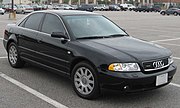


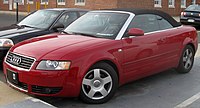


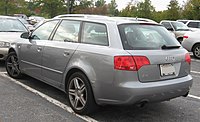


No comments:
Post a Comment